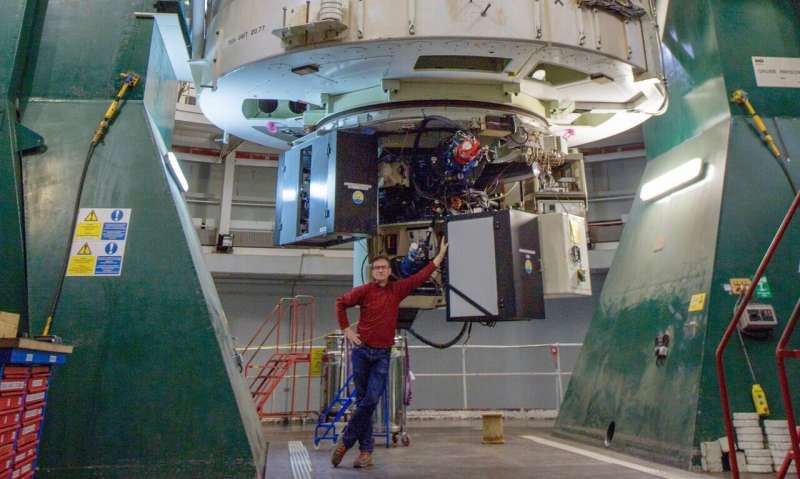New frontier for science as astronomers detect gas molecules in comet from another star

An international team of astronomers, including Queen's University Belfast researchers, have made a historic discovery, detecting gas molecules in a comet which has tumbled into our solar system from another star.
It is the first time that astronomers have been able to detect this type of material in an interstellar object.
The discovery marks an important step forward for science as it will now allow scientists to begin deciphering exactly what these objects are made of and how our home solar system compares with others in our galaxy.
"For the first time we are able to accurately measure what an interstellar visitor is made of, and compare it with our own Solar system," said Professor Alan Fitzsimmons of the Astrophysics Research Centre, Queen's University Belfast.
Comet Borisov was discovered by Crimean amateur astronomer Gennady Borisov in August. Observations over the following 12 days showed that it was not orbiting the Sun, but was just passing through the Solar system on its own path around our galaxy.
By 24 September it had been renamed 2I/Borisov, the second interstellar object ever discovered by astronomers. Unlike the first such object discovered two years ago, 1I/'Oumuamua, this object appeared as a faint comet, with a surrounding atmosphere of dust particles, and a short tail.
Alan Fitzsimmons and colleagues from Europe, the United States and Chile used the William Herschel Telescope on La Palma in the Canary Islands to detect the gas in the comet but doing so was tricky.
He said: "Our first attempt was on Friday 13 September, but we were unlucky and were thwarted by the brightness of the sky so close to the Sun. But the next attempt was successful."
Astronomers at the observatory pointed the giant telescope at the comet low down in the morning sky between 6am and 7am last Friday. Passing the faint comet light into a spectrograph, this enabled the astronomers to measure how much light the comet was emitting as a function of wavelength, or colour.
Professor Fitzsimmons explained: "A spectrum allows us to detect individual types of gas by their spectral fingerprints. We received the data at midday and by 5pm that evening we knew we had successfully detected gas for the first time."
The gas detected was cyanogen, made of a carbon atom and a nitrogen atom bonded together. It is a toxic gas if inhaled, but it is relatively common in comets.
Combining these spectra with filtered images of the comet obtained with the TRAPPIST-North telescope in Morocco, the team also measured the amount of dust being ejected by the comet, and placed limits on the size of the central nucleus.
Dr. Emmanuel Jehin is monitoring the comet using the TRAPPIST-North telescope in Morocco, and provided data crucial for measuring the amount of comet dust emitted by 2I. He said "We are used to seeing comet images, but this one is so special ! Looking at it nearly every morning for two weeks now, I'm fascinated by the fact this object is not like the many others I have been observing, but is truly coming from another star probably very far away."
Professor Karen Meech from the University of Hawai'i had previously imaged the comet, and used the new data to calculate the possible size of the comet.
She reported: "Our preliminary analysis using the amount of gas seen coming off the nucleus suggests that it is likely that much of the surface is active, in contrast to typical short period comets."
The team concluded that the most remarkable thing about the comet is that it appears ordinary in terms of the gas and dust it is emitting. It looks like it was born 4.6 billion years ago with the other comets in our Solar system, yet has come from an—as yet—unidentified star system.
As the comet approaches the Sun it will become brighter and more visible to astronomers. Dr. Oliver Hainaut from the European Southern Observatory said "The next year is going to be extremely exciting, as we will be able to follow 2I's evolution as it zooms through our Solar System. In comparison, we had only a few weeks to study `Oumuamua before it became too faint."
The European Space Agency approved a space mission earlier this year that may visit a future interstellar visitor. Dr. Colin Snodgrass in the team is also Deputy Principal Investigator on the ESA Comet Interceptor, due to be launched in 2028.
The research has been submitted to the Astrophysical Journal Letters for scientific peer review, and is available at arxiv.org/abs/1909.12144
More information: Detection of CN gas in Interstellar Object 2I/Borisov, arXiv:1909.12144 [astro-ph.EP] arxiv.org/abs/1909.12144
Journal information: Astrophysical Journal Letters
Provided by Queen's University Belfast



















